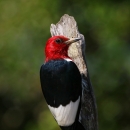Seasons of Wildlife
During the spring, the refuge begins to wake up from the long winter. Grasses green up and early flowers, such as prairie violet, begin to bloom and add color to the landscape. American woodcocks perform their courtship displays of sky dancing at dawn and dusk. Bald eagles, year round residents, can be seen tending to their nests as spring progresses. At the peak of migration, the refuge offers great opportunities to view many migrating songbirds and waterfowl. Ticks are not exempt from this revival on life and can be thick in the spring through early summer. Listen for the thrilling unison call of sandhill cranes.
Summer ushers in more blooming flowers, baby animals and a multitude of insects. Many species are bringing new life into the world as summer arrives. By mid-summer, observant visitors may be treated to the sight of one or two rusty-colored sandhill crane colts, following their parents and learning to forage on insects and invertebrates. Fawns can be seen in the prairie and oak savanna following mom around. Juvenile eagles begin learning to fly. With eight active eagles’ nests within 3 miles of the refuge boundary, there are great opportunities to spot eagles flying in the sky. Eastern bluebirds, common inhabitants of the refuge, can be seen flying around looking for insects to eat. This well-known species is a focal point for the spring habitat day event, where people can make their own bluebird houses to put up at home.
Fall is a transition time at the refuge, offering spectacular color. The reddish hue of big bluestem, golden glow from aspen and the dark reds of the bur oaks, provides a perfect backdrop. In early fall, many species are on their southward migration, resulting in more opportunities to view many species of songbirds and waterfowl. Wood ducks are one of the earlier migrants for waterfowl. Get to the refuge before the end of September to see these birds in beautiful plumage. Many other species of waterfowl can be found utilizing area lakes and rivers. White-tailed deer, year round residents, are commonly seen early in the fall, before hunting season. Along the edge of wetlands and woodlands and in the oak savanna are good areas to spot deer.
Winter brings large changes to the landscape. Snow covers the ground, and the lakes and rivers freeze. Trumpeter swans are commonly observed in early winter, before the Platte River freezes over. If conditions are just right and pockets of the river stay open, these birds can be observed all winter long. Spotting a river otter can be a real treat. Otters and their signs are commonly spotted along the edge of the Platte River. Look for the characteristic hop and slide tracks in the snow to locate the areas they use. Winter is not often thought of as the time to go birding. While the refuge does not host the variety of species that other time of years hold, many common winter inhabits can be spotted at the refuge including blue jays, crows, black capped chickadees, white breasted nuthatches and downy woodpeckers.
Resources
eBird
Recent bird sightings at Crane Meadow National Wildlife Refuge are reported to eBird. You can also see refuge specific sightings by visiting eBird’s Explore page.
eBird is created and maintained by the Cornell Lab or Ornithology in partnership with National Audubon to gather information on bird sightings. Anyone can contribute bird sightings to eBird and sightings from the refuge will appear here within 15 minutes. This also enables you to find out which birds are being reported and where. These observation records become part of an online checklist program that scientists and birders with internet access can use to review bird observation information from specific locations globally, including many national wildlife refuges. You can create a free eBird account, read their quick start guide or take their free eBird essentials lessons for more information!
iNaturalist
Are you wondering what you might see while visiting Crane Meadows National Wildlife Refuge? Did you get a great photo during your visit and are looking for a place to share you sighting with a community of people who are enthusiastic about what you saw? Did you snap a phot and want help identifying it? You can join iNaturalist.org where there is a community of citizen scientists and experts who will appreciate your sightings and can help you figure out what you sighted!
iNaturalist is maintained by the California Academy of Sciences and is a tool to connect people to nature as well as help people participate in citizen science. Anyone can contribute sightings to iNaturalist and sighting from the refuge will appear here after someone submits an observation. If you would like to participate, simply create a free iNaturalist account, read their getting started guide and start making observations of plants and wildlife!
Featured Species
Oak savanna, prairie and wetlands make up the major habitat types at Crane Meadows National Wildlife Refuge. With a diversity of habitats, the refuge supports a wide array of wildlife.


